
How to pair an abelia?
Some ideas to guide you
Contents
Shrubs with a beautifully arched habit, the Abelias are known for their abundant flowering, with blooms primarily in shades of pink or white. They emit a light fragrance throughout the summer while attracting pollinators. Furthermore, they are very easy to cultivate. These are therefore plants to adopt without delay in the garden.
While some specimens can reach 2 m in height, most varieties have a lower growth, around 1 m. They are perfect candidates for small spaces. They add a touch of romance with their often highly ornamental foliage.
Abelias prefer light soils and sunny exposures, and are quite hardy shrubs, making them suitable for most climates. Additionally, they tolerate wind fairly well, including near the sea.
Finally, depending on the variety chosen, you can use them as standalone plants, in a border, or as a free-standing hedge, and even in pots. Here are some ideas for pairing them.
In a low hedge
For a small free-standing hedge of approximately 1 m, you can choose Abelia parviflora ‘Bumble Bee’ which will have more or less evergreen foliage in winter and will reward you during the summer with its lightly scented flowers or Abelia grandiflora ‘Hopley’s’ with large flowers whose semi-evergreen and variegated foliage is very bright.
Pair them with species that have evergreen foliage such as box or Lonicera nitida ‘Tidy Tips’, also known as box-leaved honeysuckle, if the latter are affected by box tree moth in your area. The shiny green leaves will contrast with those of the Abelia. The Mexican orange blossoms with low growth such as Choisya ternata ‘Apple Blossom’ are also good companions with their fragrant foliage when crushed. These are shrubs to place near pathways so you can enjoy their scent.

Abelia grandiflora ‘Hopley’s’, Lonicera nitida ‘Tidy Tips’ (photo jellyfish57) and Choisya ternata ‘Apple Blossom’
In a free hedge
If, on the contrary, you wish for a tall hedge to break the wind or view, turn to larger specimens such as Abelia grandiflora ‘Semperflorens’ which flowers continue until October or the Abelia chinensis which is one of the hardiest varieties.
Other spring-flowering bushes like lilacs and viburnums, or Amelanchier canadensis ‘October Flame’, whose leaves also have significant ornamental interest in autumn with their bright red hue, combined with the large Abelias, will create beautiful flowering hedges for a large part of the year.
To ensure the hedge maintains a relatively opaque character throughout the seasons, it will be necessary to associate it with evergreen shrubs such as Laurel-tin Viburnum tinus ‘Lisarose’ or Photinia x fraseri ‘Magical Volcano’, a new variety whose red foliage year-round will highlight the white flowering of the Abelias.

Abelia chinensis, Viburnum tinus ‘Lisarose’ and Syringa meyeri ‘Palibin’ (photo Wikipedia)
Discover other Abelia
View all →Available in 1 sizes
Available in 2 sizes
Available in 1 sizes
Available in 3 sizes
Available in 1 sizes
Available in 3 sizes
Available in 1 sizes
Available in 1 sizes
Available in 2 sizes
Available in 1 sizes
In the border of a flowerbed
On the edge, small-growing Abelias like Abelia grandiflora ‘Prostata’ or Abelia zanderi ‘Little Richard’ will be perfect.
For a contemporary feel, you can pair them with low grasses. A mass planting will catch the eye.
For a more romantic atmosphere, Heucheras and Geraniums will complete the foreground. Small roses are also good companions. In the background, Miscanthus will add verticality and Hydrangeas will provide volume.

Abelia zanderi ‘Little Richard’ (photo Wikipedia), Heuchera ‘Wild Rose’, Hydrangea paniculata ‘Polestar’ and Geranium ‘Blue Cloud’
Read also
Growing Abelia in a potIn the background of the flowerbed
In the background of the border, larger Abelia plants, around 1.5 m high, will be more suitable. The variety Abelia grandiflora ‘Pink Pong’, in addition to its violet-pink flowering that continues until October, has semi-evergreen leaves that display beautiful autumn hues. Flowering bushes such as Buddleias, Philadelphus, and Lilacs will create a lovely backdrop.
The Abelia grandiflora ‘Pinky Bells’ has purple leaves that turn green, with bronze tones in autumn, and will pair well with the Sambucus nigra ‘Black Lace’ or other shrubs with dark foliage. You can also create contrast by placing shorter plants with grey foliage, such as Perovskia, in front.
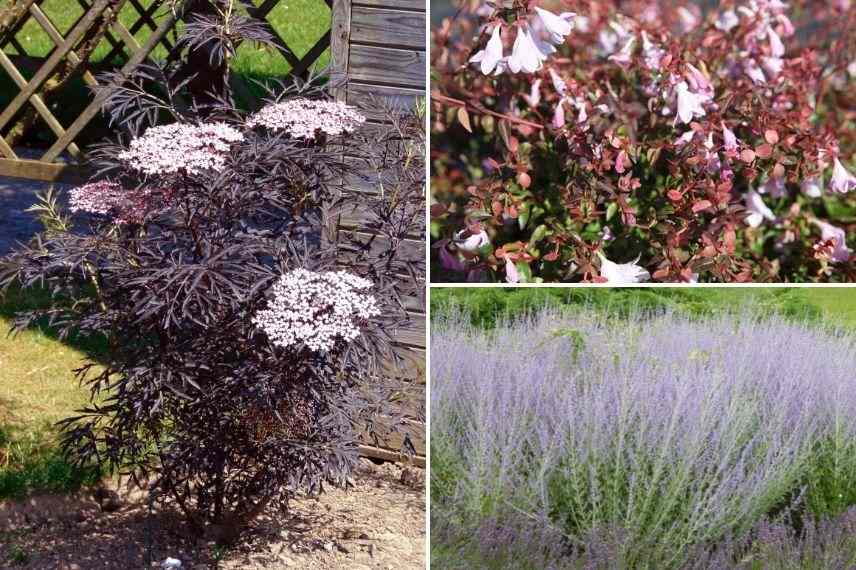
Sambucus nigra ‘Black Lace’, Abelia ‘Pinky Bells’ (photo Denolf) and Perovskia ‘Blue Spire’ (photo pixabay)
In an autumn setting
To create an interesting autumn border, select Abélia, whose leaves take on a beautiful purple hue with the onset of cold such as Abelia grandiflora ‘Radiance’ or ‘Tricolor Charm’. The Abelia grandiflora ‘Caramel Charm’ has a shimmering foliage throughout the year with its coppery then golden colour.
Pair it with a Weigelia or a Berberis, such as the Berberis thunbergii ‘Atropurpurea Nana’ with its colourful berries in autumn. Heucheras and Cyclamens are also interesting plants to use at their feet during this season.
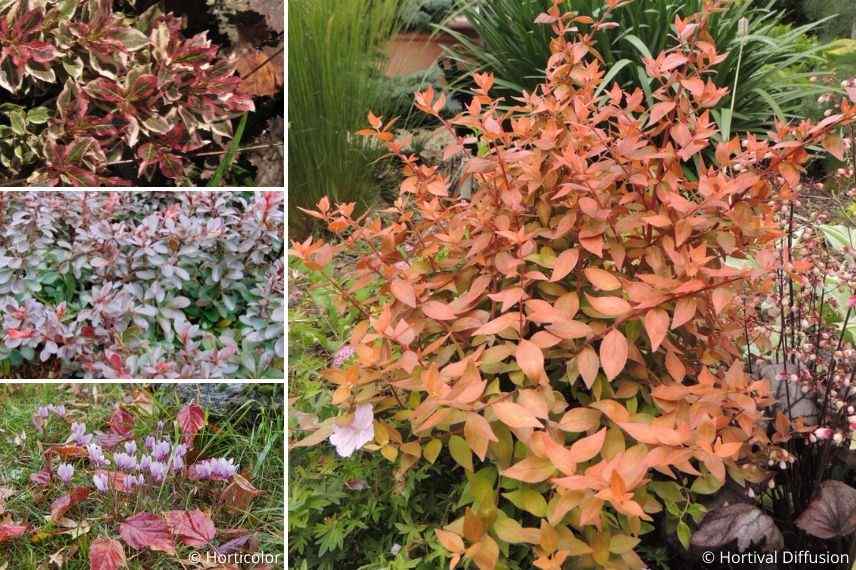
Weigelia florida ‘Monet Verweig’ (photo PBK), Berberis thunbergii ‘Atropurpurea Nana’, Cyclamen hederifolium and Abelia ‘Caramel Charm’
In a flowering pot
It is entirely possible to create a floral display in a large pot by combining small-growing Abelias such as Abelia grandiflora ‘Sparkling Silver’ or Abelia grandiflora ‘Magic Daydream’ with other perennial plants featuring interesting foliage, such as heucheras and cyclamens. Varieties with purple hues, such as Heuchera ‘Velvet Night’ or Cyclamen cilicicum pink with marbled foliage will look stunning.
Add some grasses from the genus Carex or Pennisetum as well as spring-flowering asters like Aster alpinus ‘Happy End’ and you will achieve a beautiful assortment that will adorn your terrace throughout the year.
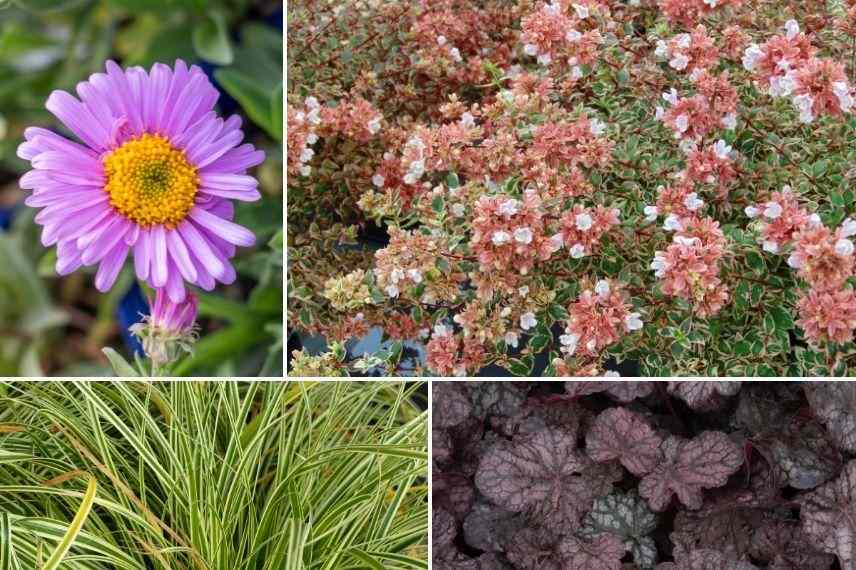
Aster alpinus ‘Happy End’ (photo Valleybrook Gardens-Flickr), Abelia ‘Magic Daydream’, Carex ‘Evercream’ and Heuchera ‘Velvet Night’
In a large container
If you have a large container, you can choose larger Abelias such as Abelia grandiflora ‘Kaleidoscope’ or Abelia mosanensis ‘Monia’, whose fragrant and very early flowering will perfume your terrace.
Hardy geraniums and petunias can be placed at their base. Other bushes can be associated with them, such as a Pieris or a creeping Ceanothus.

Abelia grandiflora ‘Kaleidoscope’, Petunia, Hardy geranium and Pieris japonica ‘Little Heath Variegata’
To find out more
Also, check out our comprehensive guide on Abelia: planting, pruning, and maintaining as well as Growing Abelia in a pot.
- Subscribe!
- Contents
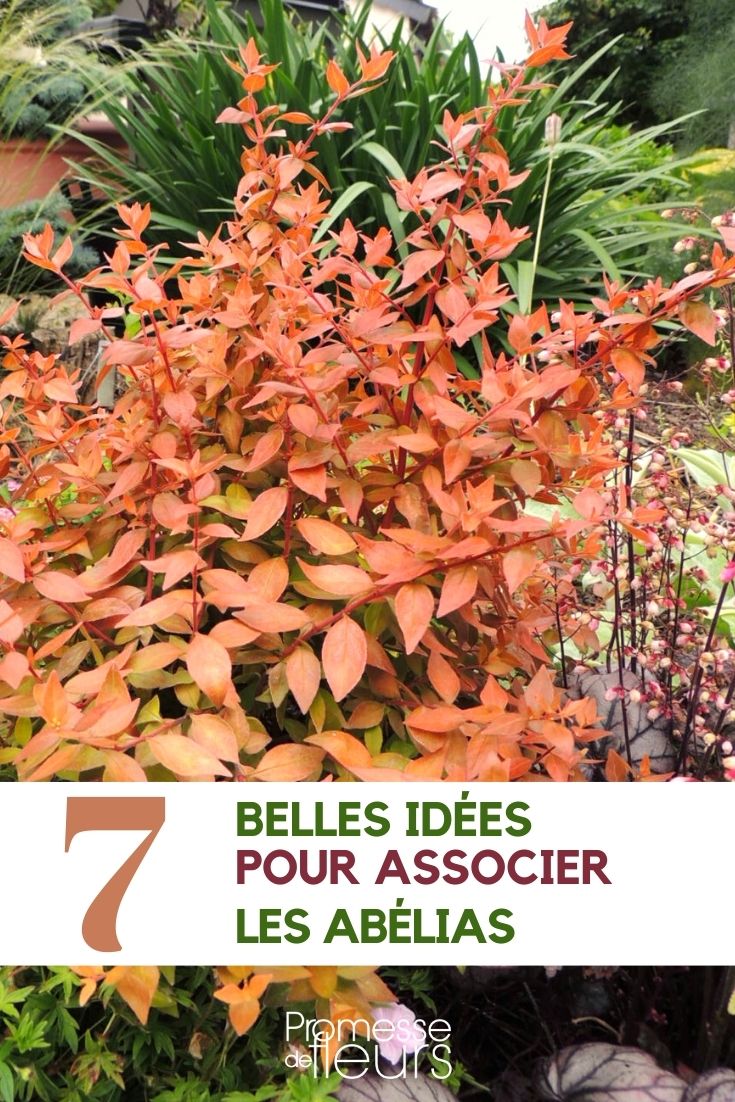































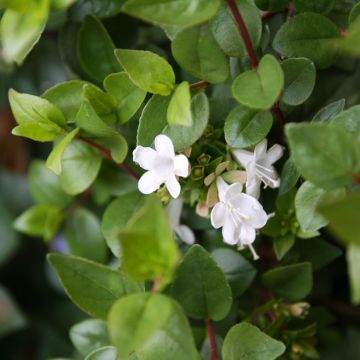
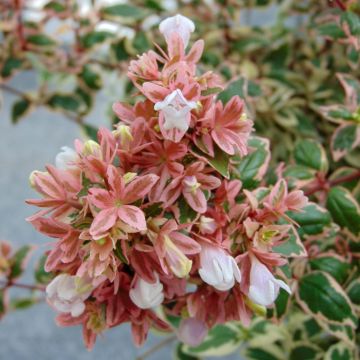


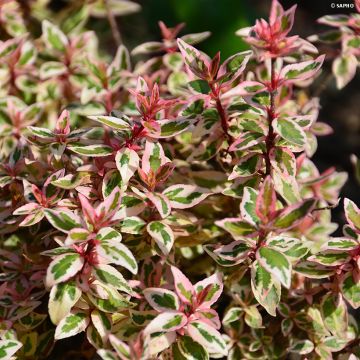
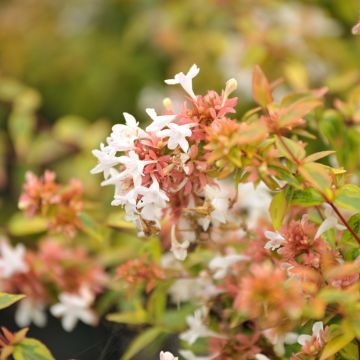

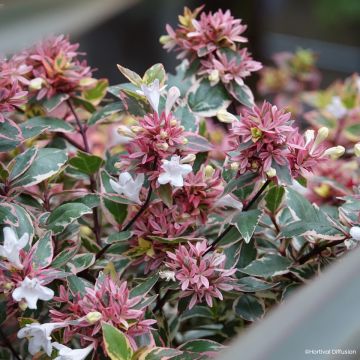
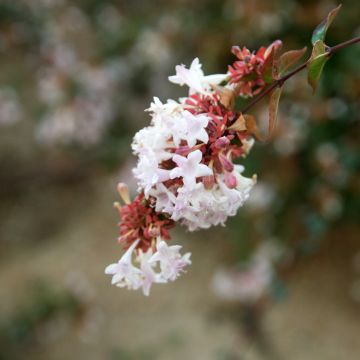
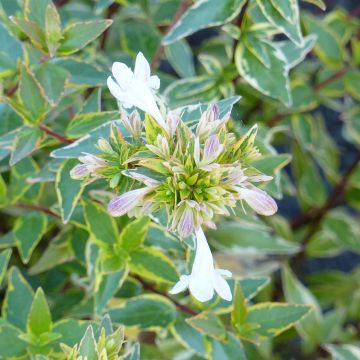
Comments